Different hues of colors signify different meanings and may even have certain effects on an individual’s mood. The coat or fur of our dog may also reflect the kind and type of personality that we have.
There are different breeds of dogs as there are different colors of coats and furs. Albino dog may catch one’s attention, not because it has a striking or multi-colored coat, but it is more likely due to its pure white color.
We are being taught the different colors during our elementary years and the basic principle that white and black are not colors. The white represents the absence of color, while the black is the presence of color.
This may be why this type of dog is called Albino, for the term “Albino” connotes as a condition of Albinism. The total absence of color is due to the inability of the animal to produce enough melanin.
In a simpler concept, “albinism” is the absence of color in the coat or fur of an animal. Though it is a rarity, however, it may appear in certain animals like dogs.
Despite its distinguishing feature of a pure white dog, not all white dogs can already be classified as Albino dogs. This type of dog has certain features that may be different from other “white dogs.” Let us explore the ten facts about Albino dogs to identify an Albino dog or just a plain white dog.
1. Albinism as a health issue.
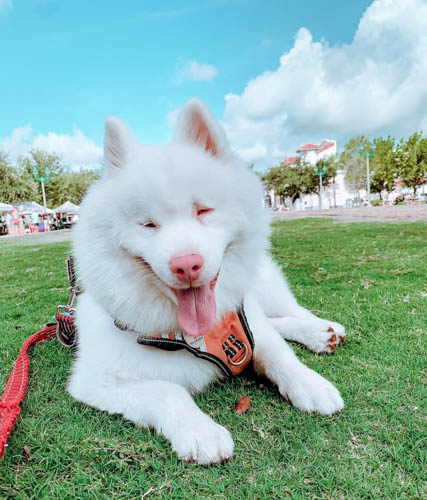
Since Albinism is a health condition, the Albino’s dog experiences certain genetic deformities, and the most obvious health concern of the Albino’s dog is the hypersensitivity to light.
This sensitivity to light affects the skin and as well as the eyes of the dog. Overexposure to sunlight may lead to skin cancer. For this reason, this type of dog is being refrained from having direct exposure to sunlight.
The associate professor of medical genetics at the School of Veterinary of Pennsylvania, Dr. Margaret Casal, firmly believes that the albinism condition of the dog will sprout to different types of deformities. Notable deformities are having some kind of bumps, non-healing sores, and sensitivity of the skin.
2. Wearing a sunglass as an eye protection.
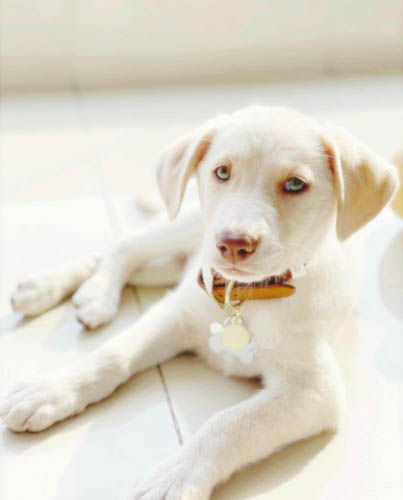
Have you seen a dog wearing a sunglass? You may first think that it is for fashion’s sake probably, it might be true for some other dogs but not with the Albino’s dog for wearing a sunglass is for the sole reason of protecting its eyes.
Sunglass may make the Albino dog looks cool, but it is for shielding the UV rays from the sun. The frailty of the Albino’s eyes needs extra care and protection.
Considering the frailty of this dog for being prone to a higher health risk as being triggered by Albinism, it is a must that extra care must be given, especially when these dogs will go out in the field.
Since their skin lacks pigment, and logically it does not have the necessary protection against the ultraviolet rays, it must take precautionary measures before letting the Albino dog go out and bask from the sun. Applying sunscreen to the dog’s body and let it wear sunglasses is a good idea.
3. Poor eye vision.

Due to the health condition of Albinism, it also affects the dog’s vision, for most of these dogs have poor vision, and sometimes some of them were born blind. Certain eye deformities were noticed in this type of dog, such as in the eye lens, iris, and sclera.
The eye deformities in the Albino’s dog may be genetic, and there is no known cure or treatment for such deformities. It has a noticeably smaller eye that may not be considered normal and sensitive to the sun’s direct rays.
4. Lack of color pigment around the eyes.
Eyes are considered the window in one’s soul, and most likely is not the case in Albino’s dog, for their eyes reflect Albinism. The condition of Albinism is apparent in the lack of color pigment around the eye area of the Albino’s dog.
Though it has attractive “pink eyes,” it is not considered “normal” pink irises. The fact that the true color of this dog’s eyes is bluish or somewhat translucent is probably due to the melatonin deficiency in the iris and retina.
As it was being noted by the veterinary ophthalmology’s assistant professor at the Tufts Cummings School of Veterinary Medicine, Dr. Stephanie Pumphrey, she states that “most dogs that are considered “albino” have a skin that appears pink around their eyes rather than the pigmented skin, which can give the eyes a pinkish look.” The Albino dog does not have pink irises, which are common to some animals that have Albinism.
5. Pink nose.

Whitecoat, pink eyes, and it is being complemented with a pink nose. Though pink noses may also be seen in other white dogs, it does not automatically make the dog an Albino dog.
After scrutiny of the nose and you can see a noticeable pigmentation around the pink nose of the dog, there is a great chance that the dog is not Albino.
The obvious characteristic of the Albino dog is the lack of pigment around the pink nose area and with the palest white coat.
6. Uncommon recessive gene.
Some people automatically jump to the conclusion that a white coat dog is an Albino dog which is not correct. The resemblance in the coat patterns, like merle, does automatically make the white dog an Albino dog. These coat patterns may be seen in some dog breeds like Collies, Australian Shepherds, Great Danes, and Dachshunds.
Albino dog has a genetic trait of Albinism, which occurs once the dog has two copies of a recessive gene. As pointed out by Dr. Pumphrey, the dog must only receive one copy of the merle gene from its parent to have the merle coat. However, when the dog receives two recessive genes, it will eventually result in Albinism’s health condition.
Albinism lacks the genetic requirements for the necessary melanin production. It is a medical fact that melanin is the pigment that is necessary for hair and skin coloring.
7. Genetic Analysis.
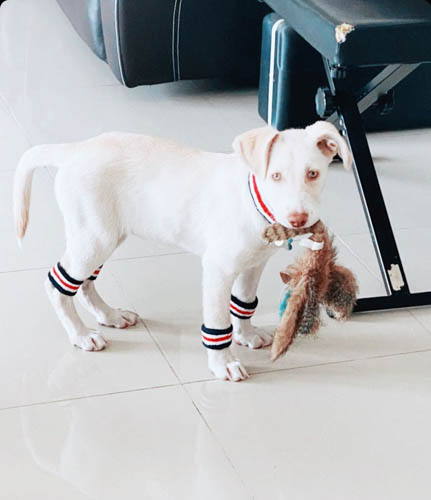
The dog’s physical features may be deceiving, and it is not proper to conclude that the dog is an Albino. To ensure that your pet is an Albino dog, it is better to secure medical analysis, specifically on genetics.
Genetic testing and analysis must be conducted on the dog to obtain proper and accurate information. There are white dogs that may manifest certain characteristics and features of an Albino dog. It looks itself must not be the determining factor for the dog to be classified as an Albino dog.
The veterinarian must carefully analyze the dog’s condition, whether it is Albinism, leucism, or just a white-coated dog. A wrong genetic analysis will lead to misdiagnosis and mistreatment, which may be critical to the dog’s health condition.
The vet will make a genetic analysis to identify the SLC45A2 gene, and once it turns out to be positive, the dog is an Albino dog.
In a recent study conducted by the Michigan State University, it was found out that the condition of Albinism is dominant to the dog breed of Doberman Pinschers. The mutated gene responsible for Albinism in Doberman Pinschers is the same that causes Albinism in human beings.
Genetically speaking, once there is a mutation, it will affect the TYR gene. Scientifically speaking TYR gene is located in the melanocyte cell in the skin, and it manufactures tyrosinase enzymes.
The tyrosinase enzymes in return produce melanocytes which are responsible for the melanin protein in the skin.
Once the TYR gene is affected, it will have a domino effect on the production of tyrosinase enzymes and melanocytes. The lack of tyrosinase enzyme may result in Albinism.
8. Albinism may be partial.
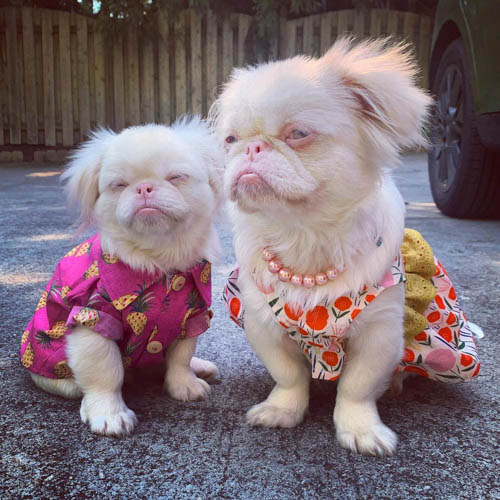
Some dogs exhibit the characteristic features of Albinism but may not be completely suffering from it. There are Albino dogs with partial Albinism or commonly referred to as leucistic.
These dogs may produce a certain level of melanin, which may produce certain coloration in the dog. You may notice certain pigmentation in the nose area and the areas around the eyes, stomach, and even in its coat.
Despite that, these dogs have partial Albinism, but still, their coat is noticeably pale compared to other white dogs. Though leucism is often being categorized as Albinism for it bears similar characteristics and features.
Still, the difference between the two is that a leucistic dog is not prone to certain health issues like an Albino dog even though it has less melanin in the body.
9. Albino’s personality.
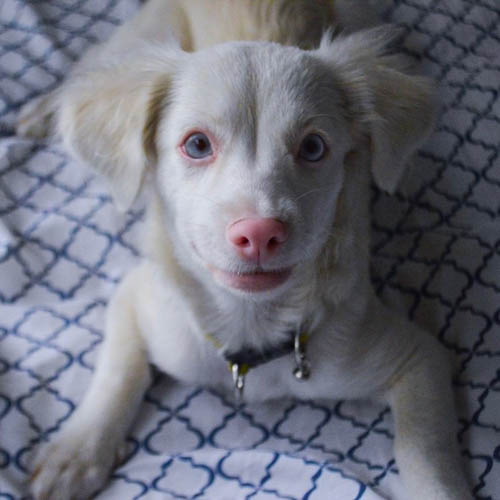
It is a given fact that this dog is “sickly” for it has a health condition of Albinism. Despite such health conditions, these dogs are still like normal dogs, wherein they have the personality of being friendly, loyal, and energetic.
Those personality traits of the Albino’s dog are just the same as other normal dogs, and surely the Albinism will not affect the bond and affection that you have with your dog.
10. Short life span.
Your fur buddy may require a great deal of care and affection due to its health condition, but you must also face the glaring reality that it has a rather shorter lifespan.
The dog’s weak immunity system and higher risk of diseases may cause such a shorter life span. Life may be short, but you can make it meaningful. Knowing that your dog may not stay longer, it is better to let them feel your love and affection.
Since Albino dogs have a short life span, most of them did not reach the “mating stage” for that reason, and Albino dogs may be considered a rarity for they cannot procreate.
However, Albino is not a type of dog breed that needs to be bred previously done by some dog breeders. It is a health condition that must be cared for with utmost attention due to its fragile condition.
Takeaway
Our fur buddy is a gift, and they may come in different coatings, sizes and the Albino dog may be considered the rarest gift. It must be showered with utmost care and affection due to its fragile condition. Enjoy every moment with your special Albino dog, for its rarity itself makes you lucky to have one.
